Abstract
Chemical mutagenesis and antibiotic enrichment techniques were used to isolate five mutant strains of the obligate anaerobe Eubacterium oxidoreducens that were unable to grow on 3,4,5-trihydroxybenzoate (gallate). Two strains could not transform gallate and showed no detectable gallate decarboxylase activity. Two other strains transformed gallate to pyrogallol and dihydrophloroglucinol but lacked the hydrolase activity responsible for ring cleavage. A fifth strain accumulated pyrogallol, although it contained adequate levels of the enzymes proposed for the complete transformation of gallate to the ring cleavage product. The conversion of pyrogallol to phloroglucinol by cell extract of the wild-type strain was dependent on the addition of 1,2,3,5-tetrahydroxybenzene or dimethyl sulfoxide. This activity was induced by growth on gallate, while the other enzymes involved in the initial reactions of gallate catabolism were constitutively expressed during growth on crotonate. The results confirm the initial steps in the pathway previously proposed for the metabolism of gallate by E. oxidoreducens, except for the conversion of pyrogallol to phloroglucinol.
Full text
PDF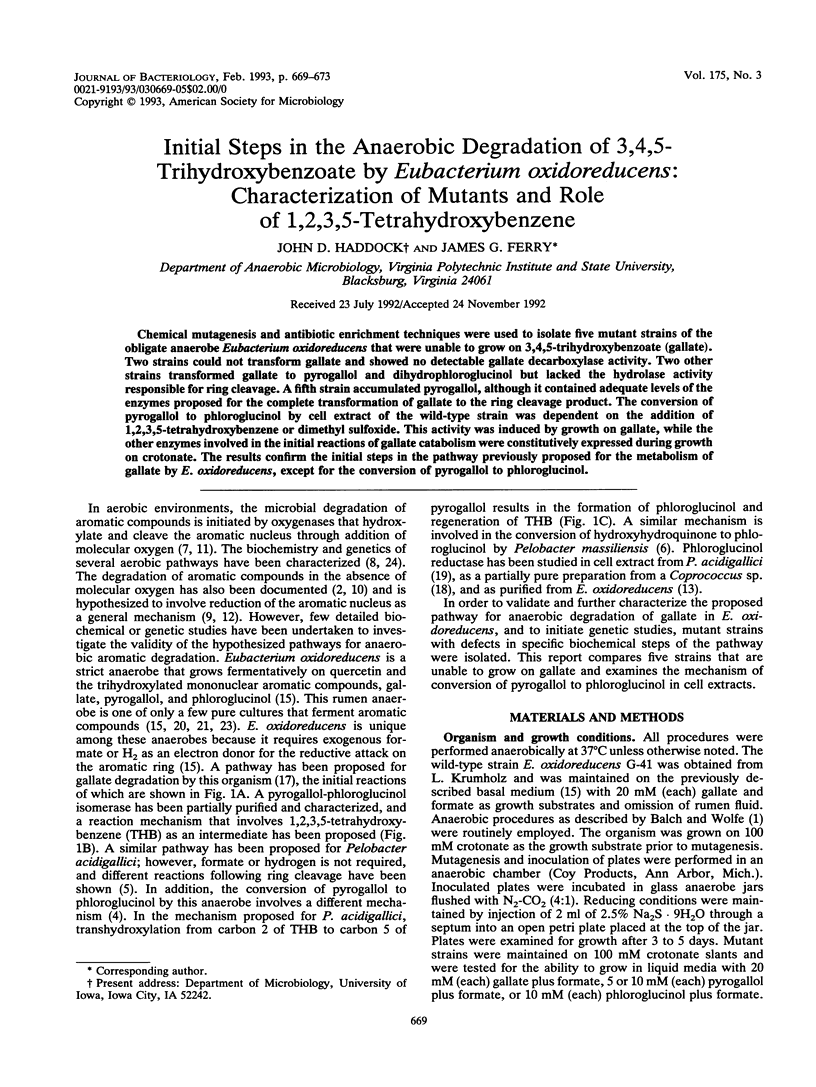
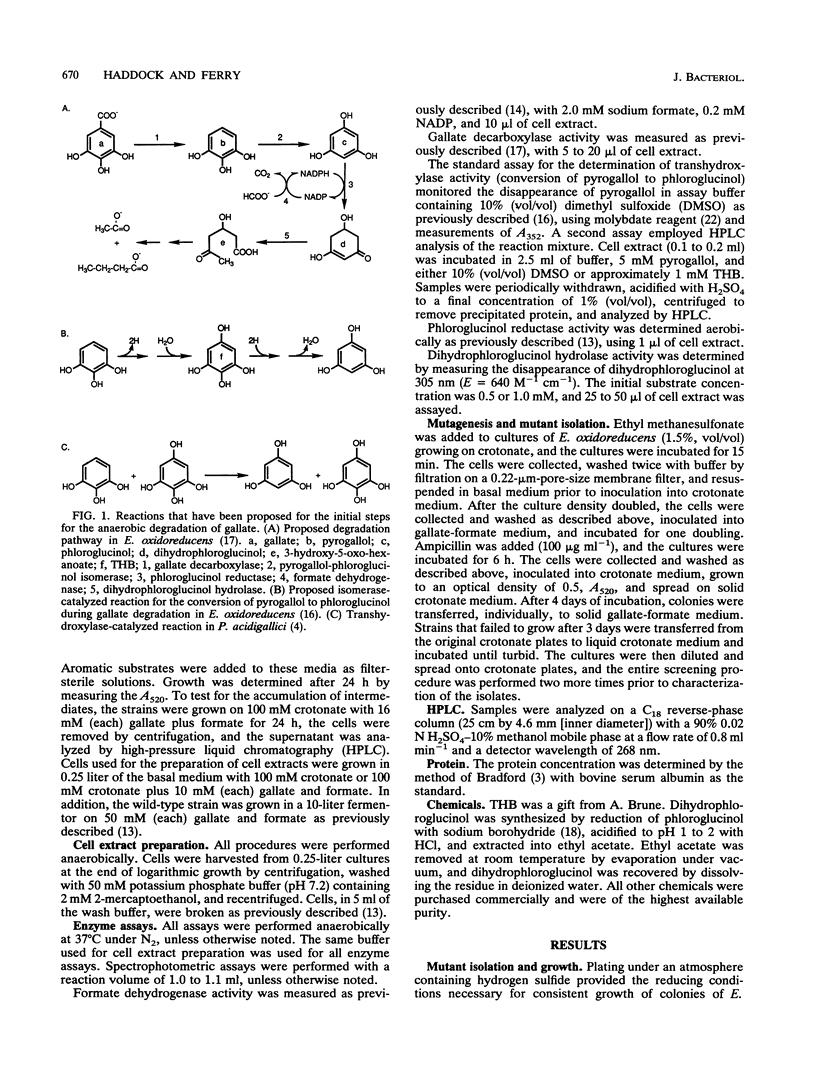
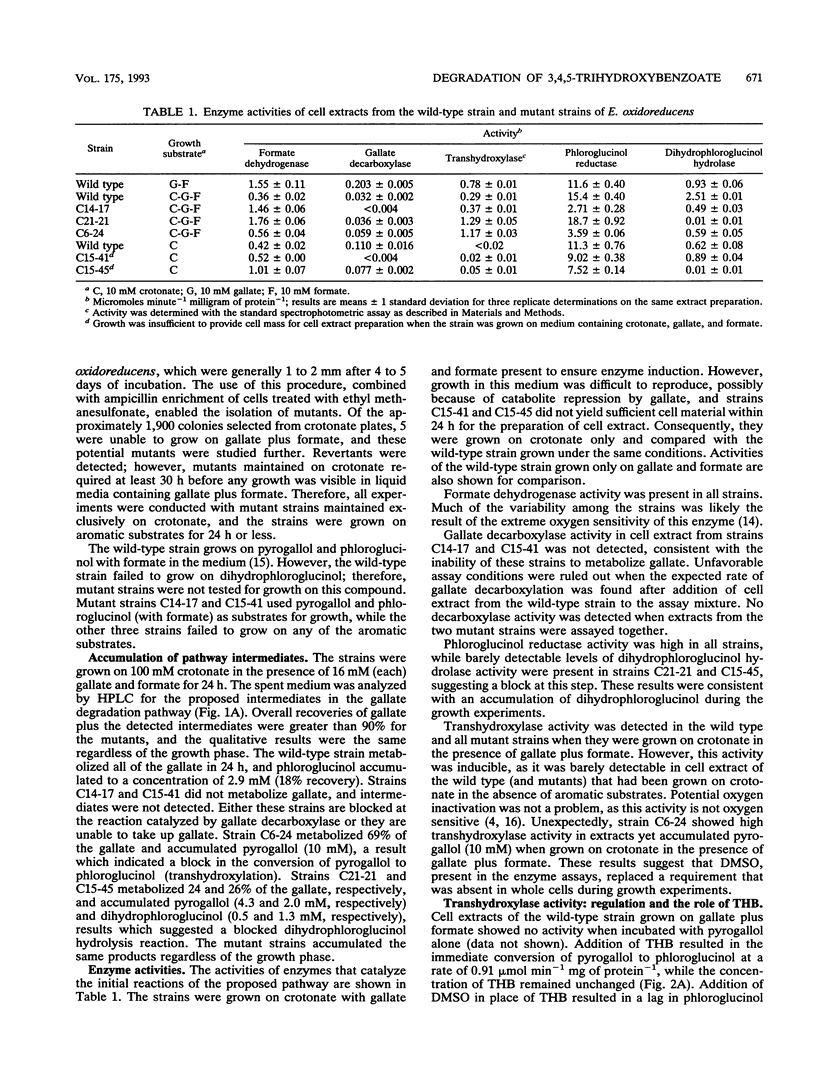
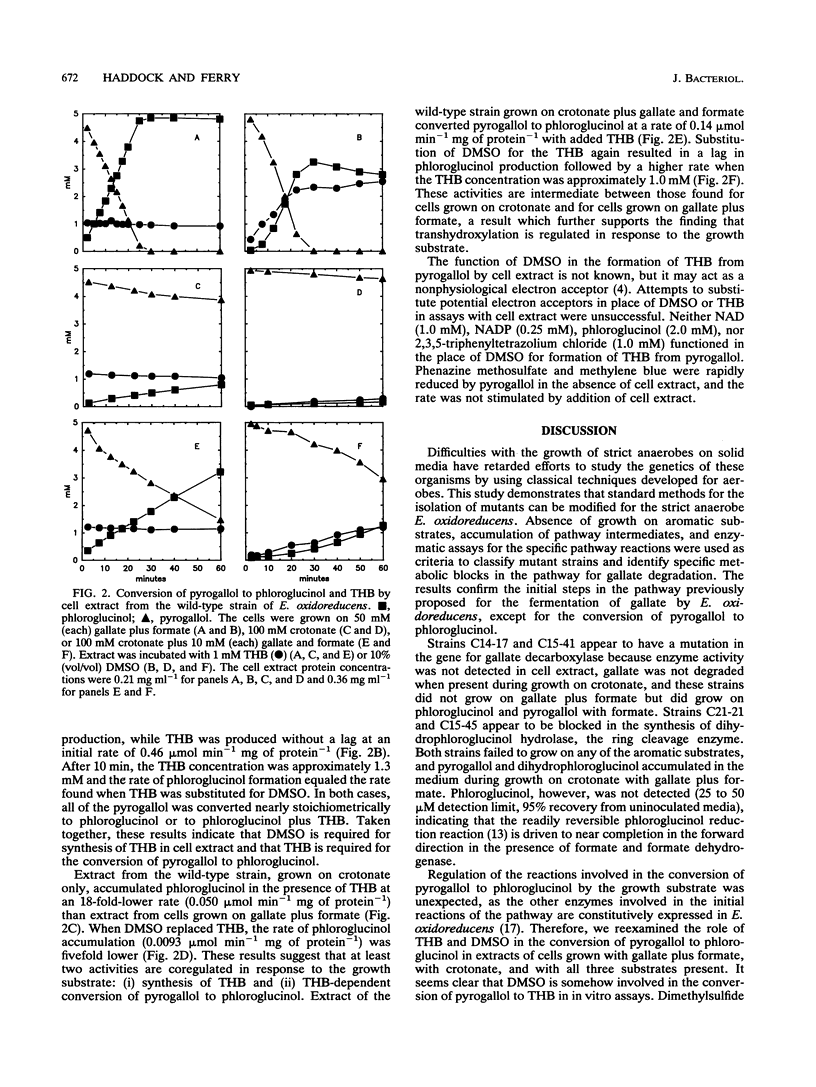
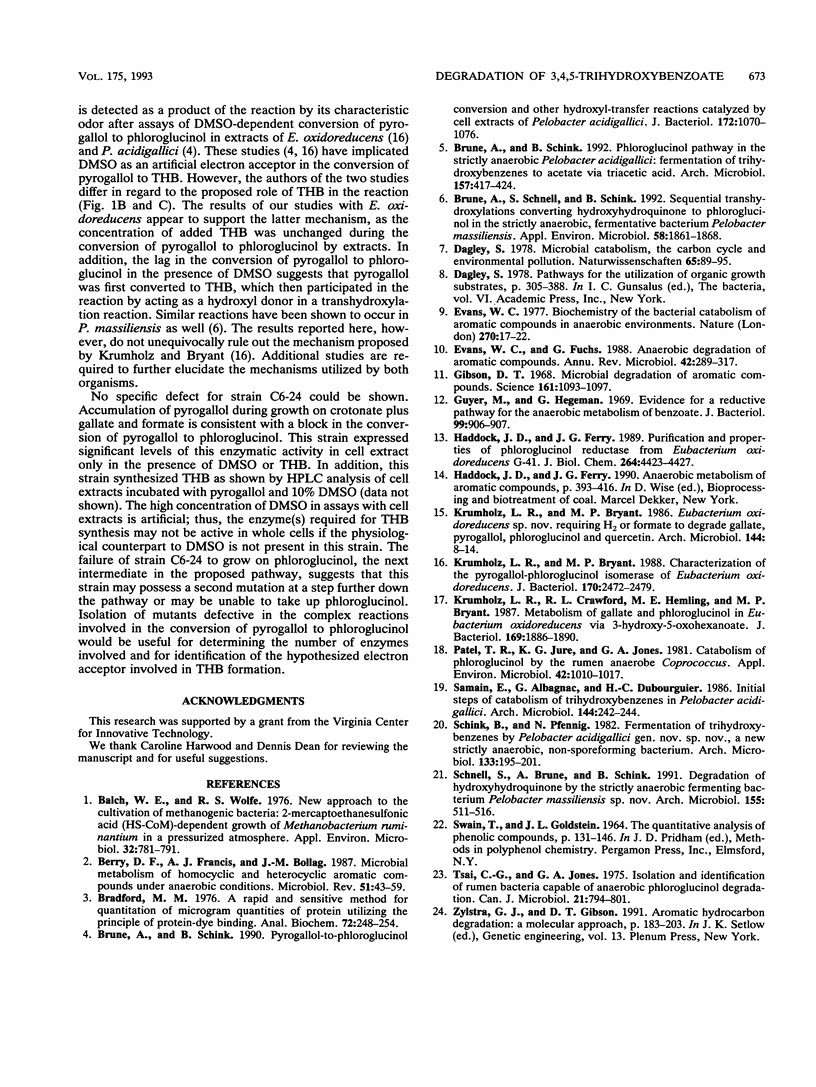
Selected References
These references are in PubMed. This may not be the complete list of references from this article.
- Balch W. E., Wolfe R. S. New approach to the cultivation of methanogenic bacteria: 2-mercaptoethanesulfonic acid (HS-CoM)-dependent growth of Methanobacterium ruminantium in a pressureized atmosphere. Appl Environ Microbiol. 1976 Dec;32(6):781–791. doi: 10.1128/aem.32.6.781-791.1976. [DOI] [PMC free article] [PubMed] [Google Scholar]
- Berry D. F., Francis A. J., Bollag J. M. Microbial metabolism of homocyclic and heterocyclic aromatic compounds under anaerobic conditions. Microbiol Rev. 1987 Mar;51(1):43–59. doi: 10.1128/mr.51.1.43-59.1987. [DOI] [PMC free article] [PubMed] [Google Scholar]
- Bradford M. M. A rapid and sensitive method for the quantitation of microgram quantities of protein utilizing the principle of protein-dye binding. Anal Biochem. 1976 May 7;72:248–254. doi: 10.1006/abio.1976.9999. [DOI] [PubMed] [Google Scholar]
- Brune A., Schink B. Pyrogallol-to-phloroglucinol conversion and other hydroxyl-transfer reactions catalyzed by cell extracts of Pelobacter acidigallici. J Bacteriol. 1990 Feb;172(2):1070–1076. doi: 10.1128/jb.172.2.1070-1076.1990. [DOI] [PMC free article] [PubMed] [Google Scholar]
- Brune A., Schnell S., Schink B. Sequential Transhydroxylations Converting Hydroxyhydroquinone to Phloroglucinol in the Strictly Anaerobic, Fermentative Bacterium Pelobacter massiliensis. Appl Environ Microbiol. 1992 Jun;58(6):1861–1868. doi: 10.1128/aem.58.6.1861-1868.1992. [DOI] [PMC free article] [PubMed] [Google Scholar]
- Dagley S. Microbial catabolism, the carbon cycle and environmental pollution. Naturwissenschaften. 1978 Feb;65(2):85–95. doi: 10.1007/BF00440546. [DOI] [PubMed] [Google Scholar]
- Evans W. C. Biochemistry of the bacterial catabolism of aromatic compounds in anaerobic environments. Nature. 1977 Nov 3;270(5632):17–22. doi: 10.1038/270017a0. [DOI] [PubMed] [Google Scholar]
- Evans W. C., Fuchs G. Anaerobic degradation of aromatic compounds. Annu Rev Microbiol. 1988;42:289–317. doi: 10.1146/annurev.mi.42.100188.001445. [DOI] [PubMed] [Google Scholar]
- Gibson D. T. Microbial degradation of aromatic compounds. Science. 1967 Sep 13;161(3846):1093–1097. [PubMed] [Google Scholar]
- Guyer M., Hegeman G. Evidence for a reductive pathway for the anaerobic metabolism of benzoate. J Bacteriol. 1969 Sep;99(3):906–907. doi: 10.1128/jb.99.3.906-907.1969. [DOI] [PMC free article] [PubMed] [Google Scholar]
- Haddock J. D., Ferry J. G. Purification and properties of phloroglucinol reductase from Eubacterium oxidoreducens G-41. J Biol Chem. 1989 Mar 15;264(8):4423–4427. [PubMed] [Google Scholar]
- Krumholz L. R., Bryant M. P. Characterization of the pyrogallol-phloroglucinol isomerase of Eubacterium oxidoreducens. J Bacteriol. 1988 Jun;170(6):2472–2479. doi: 10.1128/jb.170.6.2472-2479.1988. [DOI] [PMC free article] [PubMed] [Google Scholar]
- Krumholz L. R., Crawford R. L., Hemling M. E., Bryant M. P. Metabolism of gallate and phloroglucinol in Eubacterium oxidoreducens via 3-hydroxy-5-oxohexanoate. J Bacteriol. 1987 May;169(5):1886–1890. doi: 10.1128/jb.169.5.1886-1890.1987. [DOI] [PMC free article] [PubMed] [Google Scholar]
- Patel T. R., Jure K. G., Jones G. A. Catabolism of phloroglucinol by the rumen anaerobe coprococcus. Appl Environ Microbiol. 1981 Dec;42(6):1010–1017. doi: 10.1128/aem.42.6.1010-1017.1981. [DOI] [PMC free article] [PubMed] [Google Scholar]
- Tsai C. G., Jones G. A. Isolation and identification of rumen bacteria capable of anaerobic phloroglucinol degradation. Can J Microbiol. 1975 Jun;21(6):794–801. doi: 10.1139/m75-117. [DOI] [PubMed] [Google Scholar]
- Zylstra G. J., Gibson D. T. Aromatic hydrocarbon degradation: a molecular approach. Genet Eng (N Y) 1991;13:183–203. doi: 10.1007/978-1-4615-3760-1_8. [DOI] [PubMed] [Google Scholar]


